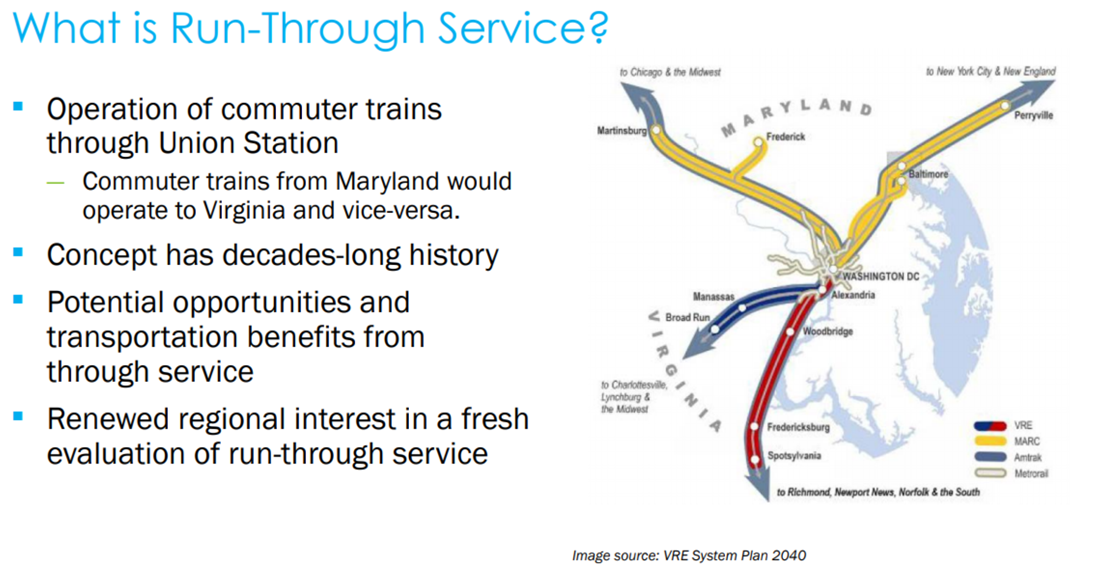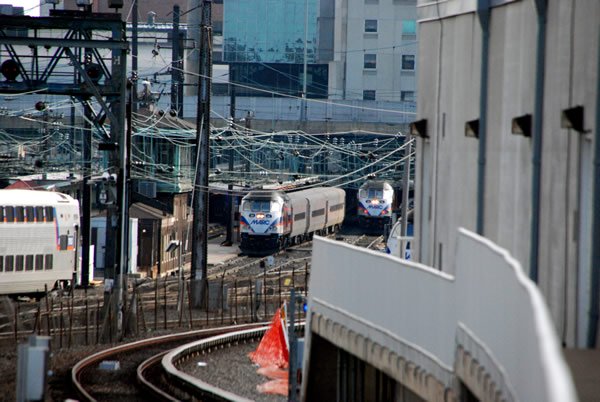What if Virginia Railway Express (VRE) and the Maryland Area Regional Commuter (MARC) service continued beyond Washington Union Station? In 2019, the Transportation Planning Board (TPB) commissioned an independent study to evaluate the market potential for VRE and MARC run-through service. The study was designed to be a first step at answering:
- What stations would attract riders for run-through trips?
- How many riders could such a service attract?
- What are some of the critical elements, operational and technical, that would need to be considered when planning for run-through service?

Decision makers are interested, here’s the background
For decades, the region’s leaders and planners have discussed the opportunity to better integrate and expand the region’s commuter rail network. In the last few years, ongoing planning initiatives and infrastructure projects have renewed interest in this concept.
The MARC Cornerstone Plan, capacity expansion proposed at Union Station, the Long Bridge rail bridge that connects the District and Virginia, and additional tracks provided by the Atlantic Gateway/DC2RVA initiatives sparked new interest in this concept. Decision makers wanted to see if there was potential to better connect the region and enhance commuter rail’s role by providing run-through service.
Several months after TPB's commitment to perform the study but before it was underway, Amazon announced its second headquarters (HQ2) would be located at National Landing near the VRE Crystal City Station in Arlington, VA. More recently, the Commonwealth of Virginia announced its intention to enter into an agreement with CSX to acquire a combination of some existing rail and adjacent right-of-way necessary to expand passenger rail capacity. In response to the efforts by Virginia, the Maryland General Assembly passed a bill during the 2020 legislative session supporting the run-through service concept; however, due to the financial impacts from the COVID-19 virus, the governor vetoed this and any new legislation that required new additional spending. Nonetheless, the Maryland bill drew additional attention to this topic and this opportunity.
Why run-through service?
Run-through service offers a range of benefits, including:
Improve jobs-housing balance - Run-through service will improve access to major employment centers and housing across the region. Residents would have access to jobs and housing within a one-seat transit ride and could reduce their dependence on driving. Run-through service can also increase the talent pool within a reasonable commute to employers, and similarly, make more jobs accessible to more regional residents.
Reduce and mitigate peak congestion on highways and Metrorail - Run-through service increases transit options across the Potomac River. It may reduce passenger crowding on Metrorail, reduce pedestrian crowding at Union Station, and increase the resiliency of our transit network by providing one more to use to cross through the core of our region. These benefits would help improve the transportation system’s reliability and resiliency.
Reduce dependency on midday train storage at Union Station - Run-through service may also provide operational benefits as it could reduce the need for trains that conclude service at Union Station in the morning and need to be stored nearby. This would reduce train crowding at Union Station.

Run-through service could alleviate train crowding at Union Station. (BeyondDC/Flickr)
Is there demand for this service?
The analysis suggests that a substantial number of people travel each day between the MARC and VRE service areas.
The consultant found that by 2030, an average of 440,000 daily trips will occur across all travel modes, in the run-through market between the VRE and MARC service areas, with most trips likely produced in Maryland and attracted to destinations (predominantly work locations) in Washington, DC and Arlington, VA. It is estimated that over 16,000 individual trips a day would be served by run-through service. Of these, most of these trips would be on the corridor between Baltimore, MD and Alexandria, VA at 11,600 trips per day. Compared to VRE’s 2030 ridership forecasts, run-through service could double ridership at L’Enfant and increase ridership by a third at Crystal City.
Caveats
There are some caveats for the study’s approach, which may call for additional analysis. The analysis was based on current service levels for both systems and the historical share of commuter rail trips in the region. The analysis is conservative and does not calculate trips induced by the new service. Today approximately nearly 14,000 riders make run-through equivalent trips to and from the service areas of the Penn & Camden lines and the VRE Shared Line, transferring to another mode to reach their destination. (The VRE shared line is the portion of the VRE system shared by both the Fredericksburg line and Manassas line, and includes the Union Station, L’Enfant, Crystal City, and Alexandria Stations.) This figure is only slightly lower than the estimated ridership of run-through service in 2030. As most run-through riders are traveling to L’Enfant and Crystal City, they already have frequent Metrorail service to their destination. While run-through service would eliminate the need to transfer, it is unknown if a net travel time savings or net increase in travel time would result from through service.
How were the potential riders identified?
The consultant used existing data to assess where riders might come from and how many might be interested in run-through service.
To identify where riders might come from, each MARC and VRE station was conceptualized as having two zones around it: a production zone and an attraction zone. Production zones describe the geography where a round trip starts and most commonly refers to a person’s home location. Attraction zones describes the mid-point of a round trip, such as someone’s place of work. Attraction zones also include airports, tourist destinations, and convention centers. Origin and destination data from MARC and VRE passenger surveys was used to define these areas.
Next the study team used travel flow data to identify the number of trips that might occur between the production and attraction zones. The study team aggregated data from the Census Transportation Planning Package and from the Maryland Statewide Transportation Model. These data sources provide information about where trips begin and end.
Next Steps
The study is intended to help stakeholders make informed decisions as they consider the possibility of run-through service. In addition to the market assessment, the consultant also identified technical considerations that will need to be evaluated in future planning for run-through service. There are several ways the region can continue planning for run-through service. The commuter rail agencies and decisions makers may take the following actions:
- Perform additional review of the results and questions prompted by the market assessment
- Evaluate existing resources and the ability to accommodate run-through service. This would include considering the construction schedule for existing, funded projects within the corridor.
- Coordinate with regional agency stakeholders to evaluate the viability of run-through service and develop a strategy that facilitates future implementation of run-through
Stakeholders in the District of Columbia, Maryland, and Virginia have already set in motion important next steps, including the Virginia Rail Improvement Program and progress on the Long Bridge Environmental Impact Statement. These projects put the region in a good position to continue to study, evaluate, and plan for run-through service.
Nicole McCall serves as the Manager of Planning Research and Assistance for the TPB. She supports regional transportation planning efforts by initiating and managing the development of data and technical methods, coordinating and considering land use and transportation planning linkages, and developing and managing projects for the UPWP Technical Assistance Program.